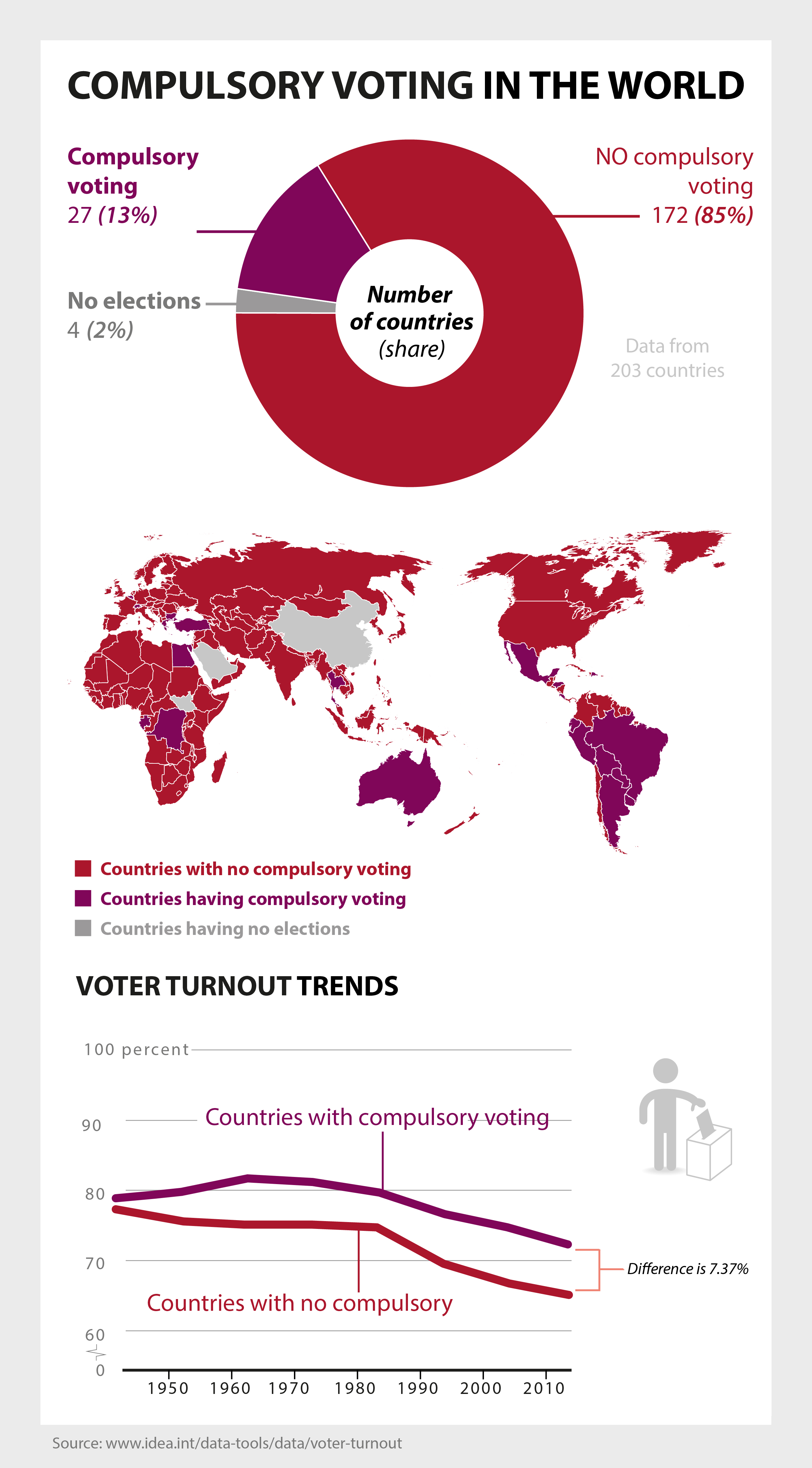Should Voting be Mandatory?
The voter turnout for 2018 in the US was 50.3%, which is the highest voter turnout percentage since 1914. Yet this number cannot compare with the voter turnout in Australia and Singapore. The turnout for 2015 in Singapore was 93.56%, and for 2019 in Australia was 91.9%. What leads to the high participation in voting in Australia and Singapore? The common thing between those two countries is that they both practice compulsory voting.
Australian citizens, except for Indigenous Australians, over the age of 18 have been required to vote since 1924 (the voting age was 21 until 1974), and it later became compulsory also for Indigenous Australians in 1984. The consequence of missing a federal election is fines that range from 20 Australian dollars, and up to 79 Australian dollars for skipping a state poll. However, voters are allowed to appeal a fine and explain why they failed to participate. And in Singapore, if a person fails to vote, that person will not be able to vote or stand as a candidate at any subsequent Presidential or Parliamentary election, until the person’s name is restored to the registers. Apart from Australia and Singapore, there are also several other countries that practice compulsory voting. Surprising as it may seem, North Korea is also one of those countries. There actually are elections in North Korea, and everyone over age 17 is required to vote. However, only one candidate appears on the ballot. Voting is actually designed to track who is and isn't in the country, and dissenting votes are possible but will lead to repercussions for voters.
So, is making voting mandatory a good or bad thing? It depends. It is no doubt that the government will be represented by a majority of the population, instead of just a few individuals. It will also guarantee that members of the society who are not as politically active will not be neglected, and the elected governments are more legitimate when higher proportions of the population participate. Moreover, people will mostly likely do more research on the candidates and get more involved in politics if they are obliged to vote. On the other hand, the arguments against compulsory voting are that it is not consistent with the freedom associated with democracy. Another consequence of mandatory voting is the possible high number of "random votes”. The voter does not care whom they vote for as long as the government is satisfied that they fulfilled their civic duty. Also, there are religious sectors that discourage their members from participating in political events. Therefore, forcing them to vote explicitly violates their right to practice their religion.
So, another question, could compulsory voting work in the United States? Anthony Fowler, a public-policy researcher at the University of Chicago, speculates that few Americans would be excited by the idea. "The idea that somebody might force me to vote might sound off-putting to a lot of American voters," because Americans don't often like being told what to do, he said. It goes against many Americans' notion of individual liberty.
Whether or not you agree with the idea of compulsory voting, one thing the government can do to encourage people to vote is to make the process of voting easier and more accessible. Something like vote-by-mail and early voting don’t require voters to be present on the polling day, which saves up a lot of time and money. These ways are already being practiced in most states in the US. The government just need to keep working on spreading them to the whole nation.
Sources:
“Compulsory Voting.” International IDEA, https://www.idea.int/data-tools/data/voter-turnout/compulsory-voting.
Moyo, Dambisa. “Make Voting Mandatory in the U.S.” The New York Times, The New York Times, 15 Oct. 2019, https://www.nytimes.com/2019/10/15/opinion/united-states-voting-mandatory.html.
Chief, Editor in. “13 Strongest Pros And Cons of Compulsory Voting.” ConnectUS, 3 Aug. 2018, https://connectusfund.org/13-strongest-pros-and-cons-of-compulsory-voting.
Rychter, Tacey. “How Compulsory Voting Works: Australians Explain.” The New York Times, The New York Times, 22 Oct. 2018, https://www.nytimes.com/2018/10/22/world/australia/compulsory-voting.html.


Comments
Post a Comment
Let your knowledge, ideas, and innovation be heard. Tell us what you think and know about this topic.